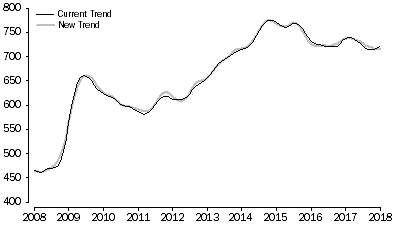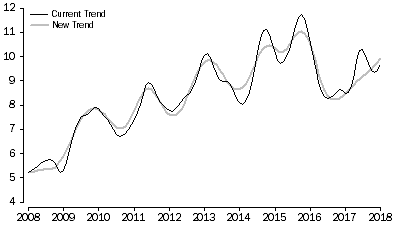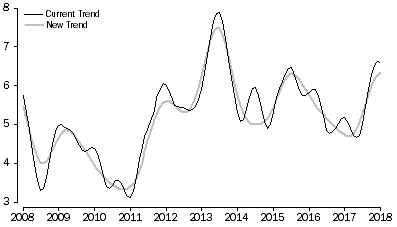IMPROVEMENTS TO TREND ESTIMATION
REPUBLISHED ARTICLE
The following article was published in the February 2018 issue of Labour Force, Australia (cat. no. 6202.0), and has been republished to coincide with changes to trend estimation in this issue, which were made as part of the recent Annual Seasonal Re-analysis.
INTRODUCTION
As part of the 2018 Annual Seasonal Re-analysis (ASR) of estimates published in Labour Force, Australia (cat no. 6202.0), the ABS has implemented an improved method of trend estimation. This article outlines details of the new trend method including the benefits and some indicative impacts on Labour Force estimates.
BACKGROUND
Period-to-period movements of the original and seasonally adjusted series are typically volatile due to the inherent variation in the data, captured by the 'irregular' component of the time series decomposition. Smoothing the irregular component of seasonally adjusted series is helpful for identifying the underlying level of socioeconomic activity. The ABS generally publishes the seasonally adjusted estimates of a raw series along with a smoothed version of the data, known as the trend. The process of smoothing seasonally adjusted data is known as "trending". Given there is an inherent and unavoidable level of volatility in original and seasonally adjusted series, the ABS encourages users to analyse both the seasonally adjusted and trend series which complement each other. The trend series provides the best indicator of underlying behaviour of time series. In the case of Labour Force statistics, trend estimates provide the best measure of the underlying behaviour of the labour market. Further information on seasonal adjustment and trend can be found in Time Series Analysis: The Basics.
The ABS established its approach to trend estimation in the late 1980s when trend statistics were first introduced into output. The approach enabled users to calculate the trend for themselves by directly smoothing the published seasonally adjusted series using the Henderson 13-term trend filter. A feature of this approach is that the trend is affected by outliers identified in the estimation of seasonal adjustment factors. While the adopted method supported some users in their interpretation of trend series, it also resulted in some quality compromises. Since the seasonal outliers are not treated, a 'ripple' effect can arise in the trend series in some situations, particularly for series with higher volatility such as those with a high level of sample error. These 'ripples' are effectively spurious turning points.
Over the decades, other national statistical organisations have also moved to publish trend series to complement the seasonally adjusted series. Generally they have adopted the core X-11 ARIMA trend which the ABS will also now adopt.
The key differences between the core X-11 trend and the traditional ABS approach to trend pertain to the treatment of "trend breaks" and the X-11 algorithm's automatic internal corrections applied in the derivation of seasonal factors. The absence of the X-11 algorithm's automatic internal corrections is known to create a "ripple" effect in ABS trend series in some situations, particularly in series with higher levels of volatility, such as those with relatively higher levels of sample error.
BENEFITS OF THE NEW TREND METHOD
A review of the current trend estimation conducted recently found that there are a number of benefits in adopting a more pure definition of the trend.
The improved trend method has a relatively minor impact on the published trend values of labour force estimates at the Australia level and for the larger states, such as New South Wales and Victoria. However, the new method provides particularly strong benefits by removing the "ripple" effects which tend to be more inherent in the current trend series for smaller jurisdictions and lower level estimates. The result of removing these "ripple" effects is trend estimates which are less volatile, and less prone to revision over time.
Improvements to trend estimation have no impact on the estimation of seasonally adjusted estimates. The new method only changes the way in which the irregular component of a time series is removed from the seasonally adjusted data to produce the published trend estimate.
IMPACTS ON LABOUR FORCE ESTIMATES
The following graphs provide an illustration of the impacts on Labour Force estimates. These are indicative impacts only, based on data up to January 2018.
Graph 1, Australia total unemployed, January 2008 to January 2018

Graph 2, ACT total unemployed, January 2008 to January 2018

Graph 3, NT total unemployed, January 2008 to January 2018

BENEFITS FOR OTHER TREND SERIES
Since the benefits to improving trend are greatest for Labour Force statistics, this change has been implemented in these series first, ahead of further changes across the range of economic statistics produced by the ABS. Information on when changes will be made to other trend series will be published in their respective statistical releases, over time.
FURTHER INFORMATION
For any queries regarding the implementation of these changes contact the National Information Referral Service on 1300 135 070, or via e-mail at client.services@abs.gov.au.
 Print Page
Print Page
 Print All
Print All
 Quality Declaration
Quality Declaration